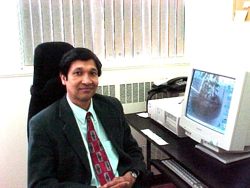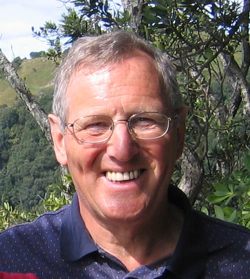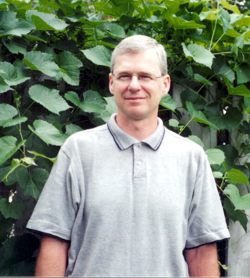Keynote Speakers
- Dr. Samir Debnath, Agriculture and Agri-Food Canada, Saint John’s
- Dr. John Proctor, University of Guelph
- Peter M.A. Toivonen, Agriculture and Agri-Food Canada, Summerland, BC
- Dr. Charlee G. Embree, Agriculture and Agri-Food Canada, Kentville, Nova Scotia
- Dr. Andrew Jamieson, Agriculture and Agri-Food Canada, Nova Scotia
Dr. Samir Debnath, Agriculture and Agri-Food Canada, Saint John’s
Title: “Developing strategies to propagate small fruit nuclear stocks of commercial interest for Canadian industry"
Small fruits are genetically heterozygous and characterized as “not coming true from seeds”. The conventional methods, although successful for vegetative propagation of these fruits, are slow and labour-intensive and few propagules are produced from a selected clone or hybrid. Micropropagation techniques are important for clonal multiplication, germplasm improvement and gene conservation of Canadian small fruits: Fragaria (strawberries), Rubus (raspberries, cloudberries) and Vaccinium (blueberries, cranberries, lingonberries, etc.) species. The in vitro propagation of these species using axillary bud proliferation and adventitious shoot regeneration has been investigated in a number of studies. The morphogenesis seems to be highly dependent on plant growth regulators and media used for culture, which is again genotype specific. The paper presents the progress in-depth of various aspects of Canadian small fruits species in vitro, on gelled and in liquid media using bioreactors, for their commercial production. It also discusses the relationship between molecular diversity and in vitro propagation, the production of apparently rejuvenated clones and the issues that still need to be addressed to utilize the full potential of plant tissue culture techniques in mass propagation of Canadian small fruit nuclear stocks.
E-mail: debnaths@agr.gc.ca
Samir is a Research Scientist with the Agriculture and Agri-Food Canada, St. John’s Research Centre in Newfoundland and Labrador and an adjunct professor in the Biology Department at the Memorial University of Newfoundland. The former professor of Bangladesh Agricultural University had been trained and worked in plant biotechnology in Germany (1984-86) and in UK (1993-94) before he joined Agriculture and Agri-Food Canada in 1996. Samir has authored and co-authored numerous publications including review papers and book chapters, in plant propagation, biotechnology and breeding. He has been an invited speaker at a number of conferences/meetings, is an active member of some professional associations, and is a director of the Newfoundland and Labrador Institute of Agrologists. His research concerns biotechnology-based value-added crop improvement. Much of his current work focuses on germplasm collection, propagation and breeding of small fruits and medicinal plants using in vitro and molecular techniques combined with conventional methods.
Dr. John Proctor, University of Guelph
Title: “Horticultural plant conservation: management and commercialization”
Most Canadian crop plants originated outside Canada, e.g. corn from
Mexico, soybeans from China. Germplasm for these crops is retained in the
Canadian Plant Germplasm System (CPGS) so that their genetic diversity,
and that of their wild relatives, is preserved. A small number of Canadian
crop plants are native to Canada, e.g. strawberry, raspberry and ginseng.
Ginseng is one of Canada’s oldest crop plants and featured in the early
fur trade. It is Canada’s most important pharmacological crop.The CPGS
preserves some native crops, but not ginseng.
In this review the history, genetic diversity, crop management and
commercialization of ginseng will be described. Worldwide the ginseng
genus (Panax L.) has 11 species, 9 from Asia and 2 from North America, P.
quinquefolius and P. trifolius. The genus is genetically diverse and the
crop plant basically undomesticated. Wild ginseng is listed as endangered
in the 1999 list of Canadian species at risk.
John Proctor is a Professor and horticulturist in the Department of Plant Agriculture at the University of Guelph. He has worked on ginseng research and technology transfer to the ginseng industry for nearly 30 years. Much of his research has focused on the micro-environmental factors involved in the growing of ginseng under a shade canopy and mulch environment. This research has provided a better understanding of these processes and suggested cultural practices for the optimal growth and flowering of ginseng. Specific projects have lead to above-ground seed stratification and associated changes in handling and seeding practices. Tissue culture studies of zygotic and somatic embryos have shown that rapid plant growth can be attained. Initial studies into the rusty root problem have indicated that it is a physiological / pathological complex.
Peter M.A. Toivonen, Agriculture and Agri-Food Canada, Summerland, B.C
Title: Fresh-cut apples: “Challenges and opportunities for multi-disciplinary research”
The fresh-cut apple industry has just become established in North
America. Much of this development has been a result of multi-disciplinary
work to find integrated and reliable solutions to problems. The future
looks very bright for this fruit product, however growth and improvement
in the quality and relative production costs will require further work.
The existing industry has grown from concept to reality in response to
research activities in package technology, sensory analysis, postharvest
physiology, postharvest pathology and food microbiology. Several examples
of how these critical research inputs impacted and continue to impact on
the industry practice. The next generation of questions and challenges
posed by the industry will require some new inputs. One example is that
the dip used to control cut-edge browning in fresh slices is reported to
be the most expensive component. New cultivars of apples which do not
brown can potentially remove this cost of production. However, these new
cultivars will also create challenges in regards to postharvest storage
research to optimize their condition and availability to the fresh-cut
processor over a storage season. Another issue which continues to plague
the industry is secondary browning, a problem caused by fungi. Sporadic
occurrence during the storage season and between lots within a storage
room has required research to develop predictors of lot to lot variation
in susceptibility. More recently, a new technology involving 1-MCP may
hold promise as a final solution to this insidious and unpredictable
problem. The very nature of fresh-cut fruit has and continues to require a
coordinated multi-disciplinary research strategy.
Dr. Toivonen received his BSc(Agr) and MSc from OAC at the University of Guelph in 1978 and 1980, respectively. He then completed his PhD in Plant Physiology from Simon Fraser University in 1985. Dr. Toivonen has been with Agriculture and Agri-Food Canada since 1989 as a research scientist in postharvest physiology. His research has focused on enhancing and maintaining quality of fresh fruit and vegetable products. In the last nine years Dr. Toivonen has been working predominantly on fresh-cut fruits and vegetables. Current activities include leading multidisciplinary research to optimize quality and safety in fresh-cut apple slices, shredded cabbage and lettuce, and studies to evaluate the potential for fresh-cut products in cherries. He is an active member of the International Fresh-cut Produce Association and chairs their working group on apple slices. He is also chair of the USDA regional project S-294 which is focused on safety and quality of fresh-cut fruits and vegetables.
Dr. Charlee G. Embree, Agriculture and Agri-Food Canada, Kentville, Nova Scotia, Canada
Title: The Current Status of Organic Horticulture Research in Canada and Recent Linkages with International Scientists in Organic Apple and Pear Production Research
Organic horticulture research has been conducted by Agriculture and Agri-Food Canada (AAFC) Scientists throughout the Nation for a number of years. The research projects have in all cases been conducted in conjunction with or complimentary to the scientists primary focus. Extensive research reports have therefore been few. Often results are made available directly to the industry producers, through the popular press or in technical publications. There is evidence that this is changing as horticultural research scientists learn of the industry's need to produce more certified organic produce to meet expanding market opportunities. The greenhouse vegetable industry is a good example. Research in organic tree fruit production in Canada is also in its early stages of development. In Feb 2006 it received a strong stimulus however, when a group of AAFC, ISHS and the Organic Agriculture Center for Canada scientists joined with the regional organic network (ACORN) to host the First International Apple and Pear Symposium in Nova Scotia. This paper will attempt to document the current status of organic research in Canadian Horticulture and to report the highlights of the International Apple and Pear Symposium.
Dr. Andrew Jamieson, Agriculture and Agri-Food Canada, NS
Title: Developing cultivars for organic production systems
The amount of fruit and vegetables produced under organic production systems, irrespective of how “organic” is delimited, has been steadily increasing. Organic production is largely based on cultivars that were originally developed for conventional production systems. The prospects of breeding specifically for organic systems are intriguing. One approach is identifying the major constraints with which organic growers must contend (often diseases or insect pests) and then incorporating stable genetic resistance. A more complex approach is to define an organic crop ideotype and derive an index of traits as a selection criterion. How effective are these methods expected to be in improving clonally propagated fruit crops? In addition to the importance of the breeding goals, the technologies employed are also of concern. The topic will be examined with special reference to breeding strawberries and apples.
Andrew Jamieson is a research scientist employed by Agriculture and Agri-Food Canada at the Atlantic Food and Horticulture Research Centre in Nova Scotia. He obtained a B.Sc. from Acadia University and an M.Sc. and Ph.D. from the University of Guelph. Breeding berry crops is his primary focus. His research emphasis is developing high quality, disease resistant strawberry cultivars. He is working with several other crops species in addition to strawberries. With the lowbush blueberry, he is developing seed-propagated varieties. He has selected several winter-hardy wine grapes which are currently under evaluation. He has an on-going program to breed winter-hardy red raspberry cultivars with improved fruit quality. More recently, he has begun to work with blackberries to attempt to combine winter-hardiness with spinelessness and large fruit size. Dr. Jamieson has contributed to the release of lowbush blueberries ‘Cumberland’ and ‘Fundy’, the strawberries ‘Annapolis’ and ‘Cornwallis’, and the grape ‘L’Acadie’. He has introduced the strawberries ‘Cavendish’, ‘Mira’, ‘Sable’, ‘Cabot’, ‘Brunswick’, ‘Evangeline’ and, most recently, ‘Wendy’.




